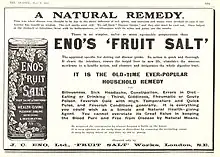Fruit salt
A fruit salt or fruit salts is an effervescent compound made up of organic acids such as citric acid or tartaric acid and salts such as sodium bicarbonate, sodium carbonate, or sodium bitartrate in combination with added flavoring and sugar. Historically, fruit salts were sold for a wide range of ailments, and today they are used primarily as antacids.
History
In the seventeenth and eighteenth centuries, scientists began uncovering the chemical make-up and physiological benefits of various salts such as Glauber's salt and Epsom salts.[1] The fact that these were found in mineral springs led to the rise of spas, where people would go to bathe in and drink mineral-rich waters for their health.[1] These developments led to attempts to replicate the salt mixtures found in these naturally occurring mineral waters using off-the-shelf ingredients.[1] Mixing these kinds of salts — especially carbonates and tartrates — with flavorings like lemon into an effervescent compound with citric or tartaric acid proved especially popular and set off a craze for the new "fruit salts".[1]
The name comes not from the popular fruit flavorings but from the fact that the acid in the mixture — which was then sourced from either citrus fruit (citric acid) or grapes (tartaric acid) — forms further salts such monosodium citrate in solution with the carbonates or tartrates.[2] "Fruit salt" thus refers both to the fruit-derived salts formed in solution and metonymically to the mixture as a whole.[3]

In 1852, the British pharmacist James Crossley Eno started selling such a fruit salt mixture from his pharmacy in the port city of Newcastle upon Tyne.[1][4] Eno gave away his mixture to seafarers at the port, and in this way the name Eno became associated with fruit salts around the world.[1] In 1868, he formally founded the company Eno's 'Fruit Salt' Works.[1][5][6]: 253
Eno's success spawned many competitors in both Great Britain and the United States, including Abbey's Effervescent Salts,[2] Dunn's Fruit Salt,[7] Slaven's California Fruit Salt,[8] and Dr. Edison Obesity Fruit Salts, for which in 1897 performer Alice J. Shaw became one of the earliest celebrity spokespersons for a weight loss product.[9] In the style of patent medicines and quackery, they were advertised hyperbolically for an enormous range of diseases and ailments, only some of which they could ameliorate (e.g. indigestion). The range spanned from cholera[10] to gout, rheumatism, colds, fevers, biliousness, indigestion, diarrhea, pimples, and headaches.[11]
As the pharmaceutical industry moved away from cure-all patent medicines in the mid twentieth century, Eno Fruit Salt became one of the few surviving products of its kind.[12]: 154 Currently owned by GlaxoSmithKline, Eno Fruit Salt is today sold as an antacid, and its main ingredients are now sodium bicarbonate, sodium carbonate, and citric acid.[13][14] Its main market is in India.[15]
References
- 1 2 3 4 5 6 7 Campbell, W. A. (June, 1966) James Crossley Eno and the Rise of the Health Salts Trade. University of Newcastle Upon Tyne Medical Gazette 60(3):350 Reprinted as an appendix to W. A. Campbell, The Analytical Chemist in Nineteenth Century English Social History, thesis presented for the degree of Master of Letters in the University of Durham. Newcastle upon Tyne, July 1971
- 1 2 Mowat, Gordon, John Alexander Cooper, and Newton MacTavish, eds. The Canadian Magazine, vol. 11, 1898, p. xli.
- ↑ "fruit salts". Collins English Dictionary. HarperCollins.
- ↑ "James Crossley Eno". Geni.
- ↑ Russell, Colin A., ed. (1999). Chemistry, society and environment : a new history of the British chemical industry. Cambridge: Royal Society of Chemistry. p. 137. ISBN 9780854045990.
- ↑ Wilkins, Mira (2004). The history of foreign investment in the United States, 1914-1945. Cambridge, Mass: Harvard University Press. ISBN 9780674045187.
- ↑ Cutler, John, Frank George Underhay, and Hugh Fletcher Moulton, eds. Reports of Patent, Design, Trade Mark and Other Cases, 1892, p. 4.
- ↑ Second Annual Report of the San Francisco Fruit and Flower Mission, 1882, n.p. (Ad)
- ↑ "She Was Fat" (advertisement), Philadelphia Inquirer (4 April 1897): 35. via Newspapers.com

- ↑ Kotar, S.L.; Gessler, J.E. (2014). Cholera a worldwide history. Jefferson, NC: McFarland. p. 242. ISBN 9781476613642.
- ↑ Advertisement for ENO. The Sunday Magazine, Collected issues of 1892. Strahan & Company, p. 892.
- ↑ Crellin, John K. (2004). A social history of medicines in the twentieth century : to be taken three times a day (Reprint. ed.). New York: Pharmaceutical Products Press. ISBN 9780789018458.
- ↑ "Eno's Fruit Salt". The Quack Doctor. 17 July 2009.
- ↑ "Eno - Summary of Product Characteristics at eMC". Electronic Medicines Compendium. Retrieved 2 September 2016.
Last updated 1 January 2016
- ↑ Srinavasan, R. "Pass Me the Fruit Salts". BusinessLine, 9 May 2012.